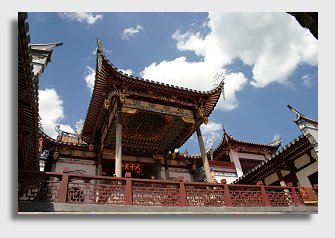 |
| Temple of Th'nee Kong, Lord of Heaven |
It is also a time for the congregation of hundreds of beggars. They will line the stone steps leading up to the temple. Chinese Penangites are particularly charitable tonight and tomorrow.
Tomorrow, the 9th Day of the Chinese New Year is the MOST important day for the Hokkiens who constitute the majority of the Chinese Malaysians in Penang. In fact, to them, the 9th Day is even more important than New Year’s Day itself or, for that matter, any other day of the year. No, I am not Hokkien but growing up in Penang, one cannot but help picking up Hokkien traditions.
My granddad told me that during the Chinese Ming Dynasty, the Hokkiens lost a war and had to flee their villages. Some books diplomatically identified the aggressors as foreign troops from the north, perhaps insinuating Manchus. Unfortunately for the Manchus, they were the usual whipping boy for the Han Chinese. But my granddad was far more blunt. He said the invaders were Cantonese from the South.
Anyway the Hokkiens fled the scene and hid in the sugar cane fields while the Cantonese warriors looked for them for several days. They prayed to Th’nee Kong for salvation. Eventually the Cantonese grew tired of their unsuccessful seek-and-destroy operations and return to their own region. A Hokkien Rwanda was avoided.
The Hokkiens emerged from the sugar cane fields, relieved that they had been spared by divine grace. Realising that it was the 9th Day of the Chinese New Year and coincidentally the birthday of Th’nee Kong, they decided to offer votive prayers to the Jade Emperor for their salvation. But they were last-minute war refugees on the run with only the clothing on their backs, so what was there to offer as sacrifice to Yu Huang, the Supreme Ruler of Heaven?
Well, they had just emerged from a sugar cane field so they each grabbed a couple of sugar cane stalks and fell on their knees in homage to the Lord of Heaven, offering the only edible item they were able to procure there and then. Since that fateful day, the Hokkiens have celebrated Chinese New Year with a pair of sugar cane plants, which must be complete stalks from roots to shoots to commemorate the actual votive offerings of that historical day.
Today, if you were to drive past houses of the more traditional Hokkien Penangites, you would be able to see two sugar cane plants, one secured on each side of the main front door - and remember, with roots and all.
And obviously Day No. 9 of the New Year has become the MOST important day in the year for them. Their race was saved by God. When the Hokkiens pray to their saviour, they would invariably offer, among many delicacies, cut and skinned sugar canes arranged as tiers on trays (I have always termed it as 'piles of mini sweet logs'), as offerings of gratitude to Yu Huang for that memorable day of salvation, and also symbolising sweetness and rising fortunes/karma.
Maybe this history lesson does in a way explains why I, with a sweet tooth, have always been partial towards Hokkien babes.
 |
| Hokkien babe from Johor and now well-known HK TV star, Vivien Yeo |

Didn't know the Penang Hill will have such crowd tonight celebrating 9th day of CNY. However, too late for me to go there now.
ReplyDeleteI believe it is the Manchus that invade the Ming Dynasty, with a traitor general opening the gate,letting them in. He then order the killing .... sad. It only stop on the 9 day and I guess the Hokkien was very thankful. ...
Thanks for posting this, lots of people just don't know why one is celebrating.
As I understand it was the Yuan dynasty that conquered China and force the Tang people to flee south away from the Yuan troop
DeleteThe Tang people has no place to hide from the marauding Yuan troop. The Tang people went into a forest of sugar cane to hide. It was after the Yuan Troop left, did the Tang subjects emerged from the sugar cane forest on the nine day of the Lunar New Year. The day being the Jade Emoeror’s birthday the Tang people used two sugar cane plants to thank the Jade Emperor for their deliverance.
That is why, most Southern Chinese of Hokkien descent refer to themselves as “Tang Ren” to this day.
The victims were Hokkiens, people from the province of same name or in Mandarin "Fujian". They were the "original or earlier Chinese until the Mandarin-speaking Northerners swept south into China. Their aggressor persecutors were Cantonese from the neighbouring province of GuangDong. Thus only the Hokkiens (unlike other Chinese from different provinces) celebrate the Jade Emperor's birthday (9th Day of new Moon) as their New Year.
DeleteToday Chinese changed the aggressors to Manchus or Yuans depending on the story teller, for political correctness - it would be extremely unpleasant to suggest there was ferocious conflict of a genocidal scale between the Cantonese and the Hokkiens (Fujianese)
I've never said this before, but that was a truly informative post, considering my family had just finished praying and I only knew a smattering of what happened. :P
ReplyDeleteWell you can alter history books or stories but not what actually happened which is the cantonese were the invaders while hokkiens were the victims.
ReplyDelete